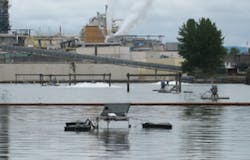Along the banks of the Columbia River northwest of Portland, Ore., the City of St. Helens has seen the growth of several industries during its 160-year existence: lumber, mining, quarrying, manufacturing and shipping, as the city was originally established as a port. The city and its industries are used to working together in many ways for the benefit of the community. One of the more unique collaborations is that St. Helens (population 13,000) and the town’s major employer, Boise Paper, share the wastewater treatment plant and even the EPA-required National Pollutant Discharge Elimination System (NPDES) permit along with it. The two organizations work together closely to meet mutual goals, the main one being to operate the plant as effectively and cost-efficiently as possible.
Toward this goal, a recent project to reduce the cost of aeration in the 42-acre lagoon led to the installation of solar-powered, long-distance circulation mixers from SolarBee Inc. The city and the mill cut their energy costs, and the project also qualified for a rebate from their serving electric utility, Columbia River PUD, with support from the Bonneville Power Administration’s Energy Smart Industrial (ESI) program. Aeration runtime costs are down more than 50%, and payback in just two years is anticipated.
Background
The St. Helens wastewater treatment plant was built in 1970 under terms of an operation-and-use agreement. Before 1970, the mill removed suspended solids with a primary clarifier and discharged into the river. Because a shared wastewater treatment plant made sense, Boise Paper donated the land to the city, and the city built the plant with municipal bonds. With the new plant, the mill gained secondary treatment and the ability to reduce biochemical oxygen demand (BOD) load. The city and the mill have shared the NPDES permit since 2004.
The current wastewater treatment plant consists of two ponds: a 3-acre primary lagoon that receives loading from the city and smaller industries, and a 40-acre secondary lagoon that receives effluent from the city’s primary pond and from the mill’s primary clarifier; the secondary lagoon is divided into three zones by baffles. Prior to the energy reduction project, 24 mechanical surface aerators in the first two zones ranged from 50 to 150 hp and operated approximately 2,100 hp per day, effectively making them partial-mix zones. The aerators were alternated to maintain thorough mixing. Five or six aerators ran constantly in Zone 1, and one aerator ran in Zone 2. A SCADA control system rotated the aerators automatically depending on the level of dissolved oxygen. Zone 3 is
a quiescent area where the solids are allowed to settle. The secondary effluent is discharged into the Columbia River, past Sauvie Island, 650 ft into the channel.
The size of the lagoon was adequate for the needs of the mill and the city when Boise Paper operated as both a pulp and paper mill. “We used to contribute 98% of the BOD load and 35 mgd,” said Alison Dean, environmental engineer with Boise Paper. “Because we were such a huge contributor, we basically treated the secondary treatment as though it was totally our cost. The mill paid for maintenance and repair even though the city owns it.”
But times changed. Boise shut down its pulp processing operations in January 2010, and today the facility operates solely as a paper mill. “We’re now down to about five million gallons a day of flow from 35 million gallons a day,” said Aaron Kunders, superintendent of the St. Helens wastewater treatment plant. “The mill was giving us between 50,000 [and] 60,000 lb of BOD a day, and now we’re getting about 1,500 lb. Despite the significant reduction in loading, we had a great system and didn’t want to have to block off part of it because we weren’t using it.”
Options
When the mill reduced its load on the wastewater treatment plant, the focus changed from maintaining the aerators to reducing the electricity required to run them. “Boise Paper was working on a variety of energy reduction projects, including reducing energy at the wastewater treatment plant,” said Dean. “We had been able to decrease aeration down to the point where mixing was the limiting factor. The secondary treatment lagoon was still expensive to operate, and we searched for ways to reduce those costs.”
Cascade Energy Engineering, a BPA ESI program implementation partner, conducted a study at the request of Columbia River PUD to consider energy-saving solutions at the plant. It studied seven months of operational data from the plant’s SCADA system, as well as input from plant personnel.
Kunders was familiar with SolarBee mixers from his first years at the plant. “Back then, we looked at SolarBee mixers to help reduce sludge. At that time, however, the budget went toward maintaining the aerators. When the focus shifted to energy savings, I brought up SolarBee products and thought we should look into them.”
Engineers considered three options in their study report (total cost consideration follows):
• Replace a portion of the existing surface aerator propeller blades to a lower pitch. This would reduce aeration power but also reduce mixing.
• Replace a portion of the existing surface aerators with aspirating aerators. This would provide adequate aeration, but would create only localized mixing due to the small impellers used.
• Replace a portion of the existing surface aerators with solar-powered mixers. This would reduce the runtimes of existing aerators or the number of aerators while also improving mixing.
According to the study, the lower-pitched propeller blades would save 119,553 kW per year; the aspirating aerators would save 91,747 kW per year; and the solar-powered mixers would save 1,375,518 kW per year.
Solutions
The goal of this project was to increase system efficiency and enhance organic sludge digestion.
“To me, the choice was obvious,” said Kunders. “Due to the energy savings and the resources available through the ESI program, Columbia River PUD was able to provide a 70% rebate for the cost of the mixers. It brought the price so far down that our payback was two years. In two years we have a payoff and in four years we make that money back. Instead of these other little projects we were thinking of, this one cost a lot more up front, but it also has the biggest return.”
The solution was to install seven SolarBee SB10000 v18 machines—five of them in Zone 1 and two of them in Zone 2. The solution was based on an influent flow rate of 12 mgd and average sludge depths of 6.5 ft in Zones 1 and 2 and 13 ft in Zone 3. The SolarBee mixers are spaced at approximately 4 acres. Each SolarBee mixer can displace between 30 and 60 hp of aeration.
Although the long-distance mixing effect of SolarBee units can also reduce BOD, “We weren’t going for that,” said Kunders. “We were going for the energy savings.”
“Right now we’re saving over 50% of horsepower,” he said. “We were at 550 hp per day before we added SolarBee mixers, and now we’re at approximately 250 hp. Plus, we’re getting nearly complete mixing at up to 20 ft deep in the 28-ft secondary lagoon. Typical aerators only mix the top 5 to 6 ft. And we’re not done turning off the aerators. We take them down in stages. We can still turn them off a little bit more, but we don’t want to upset the lagoon. At first we were saving 40%; now we’re saving over 50%. Down the road, we may turn them off more, but probably not until fall. During the summer, we take more advantage of the algae in the water. It’s producing oxygen, so we bring up everything from the bottom to mix with the oxygen.”
Results
The success of the project prompted the city to install two more SolarBee mixers in the primary lagoon, which receives loading from the city and a few smaller industries. “The two additional SolarBees will cause us a little more maintenance because there’s a lot more debris in that lagoon—rags and stuff—but we’re hoping to shut off at least one aerator a day throughout the year,” said Kunders.
Kunders says that the biggest payoff of the project is for taxpayers.
“The cost for all these SolarBee mixers was offset so the cost doesn’t have to go to our taxpayers,” he said. “Instead of paying 100% of it, the city probably paid 10% of it (between the rebate and the mill’s contribution), which is incredible. The citizens got a great deal on it.”
With the wastewater treatment plant now redesigned for cost-efficient operation, St. Helens is poised for industrial growth, and the local economic development association is actively seeking industry. Already there is talk of building a new port terminal to accommodate coal exports shipped from Wyoming to China. The partnership has paid off for residents, city and mill—and for the community’s future economic well being.



